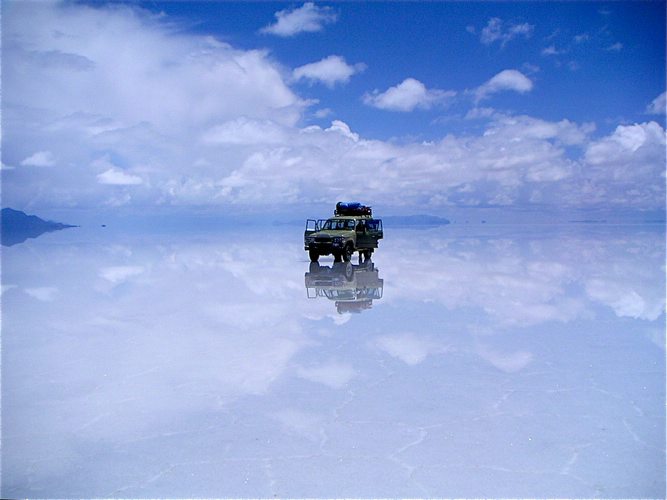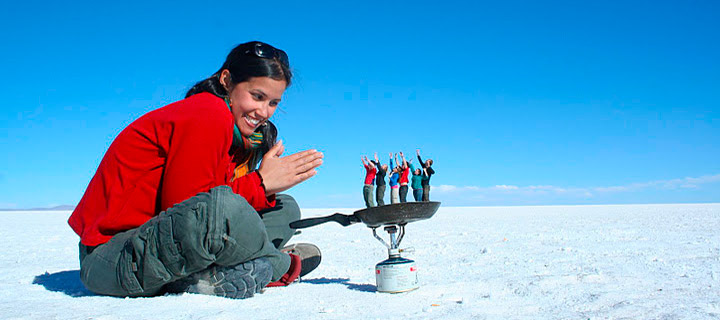On the crest of the Andes lies the jewel of the Bolivian altiplano: the Uyuni Salt Flats. Widely known as the world’s biggest salt flat, Uyuni is home to some of the most surreal sights on earth, from multi-colored lagoons and glorious peaks, to water-covered surfaces of salt that mirror your own reflection. The Andean Treasures & Bolivia Highlights tour takes you on a 3 day journey to Salar de Uyuni, to show you the highlights of this majestic place.
Uyuni Salt Flats Travel Guide
Uyuni Salt Flats: an introduction
How to get there
The highlights: what to expect from your tour
Uyuni Salt Flats: an introduction
It comes as no surprise that this is the largest salt flat in the world: Salar de Uyuni spans more than 4,086 mi sq (10,582 km sq). During the region’s rainy reason, the salt flats gets covered by a layer of clear water, creating the illusion of a giant natural mirror. Visitors feel as if they are walking on the sky!
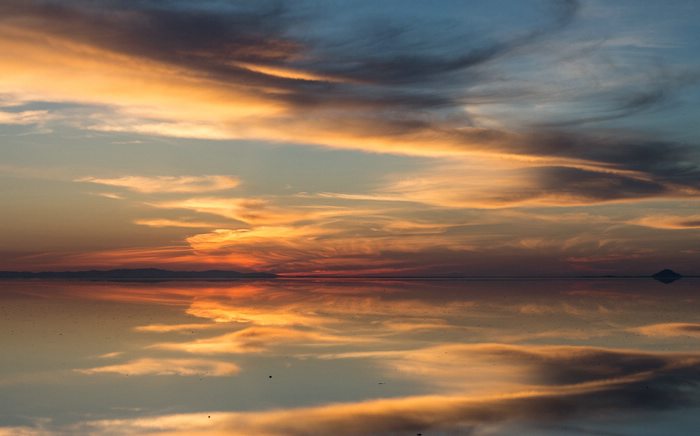 Salar de Uyuni: a natural mirror to the sky
Salar de Uyuni: a natural mirror to the sky
Photo by Pedro Travassos/Flickr
Impress your travel buddies with these fun facts about the Uyuni Salt Flats. Did you know that …
- The Uyuni Salt Flats are home to approximately 50-70% of the earth’s total lithium resources (which are used to make batteries)
- The Uyuni region has minimal wildlife in general, but is an important breeding ground for different species of the Pink Flamingo
- The salt crust of Uyuni ranges from a few centimeters up to 32 ft (10m) thick
- Salar de Uyuni has a train cemetery – trains were made there until 1940
- These salt flats are located at an elevation of 11,995 ft (3,656 m) above average sea level
How to get there
Various transportation options exist for getting you to the Uyuni Salt Flats, via road or air. Your tour of the Bolivian salt flats will begin in a remote village named Uyuni, to which you will arrive by airplane from La Paz – the quickest and easiest transportation method.
 Looks just like sand! Piles of salt in the Bolivian Uyuni Salt Flats.
Looks just like sand! Piles of salt in the Bolivian Uyuni Salt Flats.
Photo by Luca Galuzzi/Wikimedia Commons
Distances :
- La Paz – Uyuni 353 mi (569 km)
- La Paz – Oruro 142 mi (229 km) [paved road]
- Oruro – Uyuni 211 mi (340 km) [unpaved road]
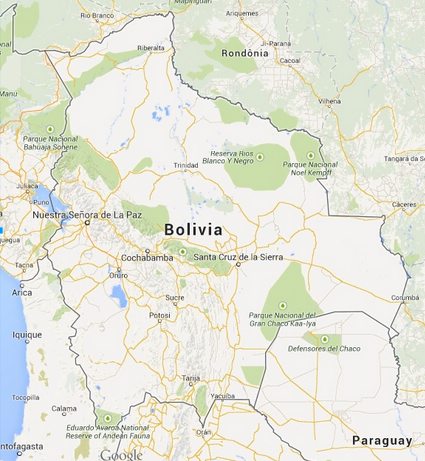 If you driving – note that you are traveling on unpaved roads for a good portion of the trip
If you driving – note that you are traveling on unpaved roads for a good portion of the trip
Map from Google Maps
Here is an overview of the travel options to reach Uyuni:
1. Airplane – 1 company flies to Uyuni
The flight between La Paz and Uyuni takes approximately 45 minutes to an hour
Note: Bolivia is not always stable, resulting in possible flight schedule changes.
So far, only 2 frequencies are available:
 2. Tourist night bus – You can take a bus from La Paz to Uyuni and visa versa, every day of the week. There are no day buses. The drive takes approximately 10 hours, but can be longer during the wet season (December to April).
2. Tourist night bus – You can take a bus from La Paz to Uyuni and visa versa, every day of the week. There are no day buses. The drive takes approximately 10 hours, but can be longer during the wet season (December to April).
3. Private transportation (4WD) – gives you the option to drive during the day and experience more of the breathtaking scenery.
4. Public transport – train, public bus
The highlights: what to expect from your tour
Now for a step-by-step overview of the highlights of your Uyuni Salt Flats Tour portion on the Andean treasures & Bolivia Highlights tour. We have carefully handpicked the most fascinating sights that are a must-see for any visitor to the salt flats!
Day 1 – Salt and sightseeing
Your salt flat exploration adventure begins almost immediately upon arrival to Uyuni. You will be transferred from the airport to Villamar to check into your hotel, and there are plenty of sightseeing opportunities along the way! Your first stop will be a popular one: San Cristobal Church, one of the oldest churches in the entire Bolivian Altiplano. Once you have taken in its idyllic beauty, it is time for your first encounter with local culture. You will pass through the villages of Culpina K and Alota, known for their picturesque architecture and charming local community.
 The historic colonial church of San Christobal
The historic colonial church of San Christobal
Photo by Samenargentine/Flickr
Your last stop before getting to the hotel is Valle de las Rocas (Rock Valley) – old volcanic rocks that have eroded for millions of years and grown into interesting shapes as a result. Be mesmerized by the changing landscapes and unique formations. Lunch will be waiting for you at your accommodation. While luxury conveniences are rather rare on the Uyuni route, this hotel goes a long way in filling the gap!
End your day with an exploration of the hotel and its surrounding area, before having dinner and getting a good night’s rest.
Day 2 – Colorful lagoons and their inhabitants
On day 2 you will embark on a full day salt flats tour. After breakfast at your hotel, you will visit the magnificent Laguna Colorada (Red Lake). The lake is filled with borax islands, whose white color stands in perfect contrast with the reddish tint of the water, colored by sediments of algae. This lake is home to the beautiful James’ Flamingo that can often be spotted there. This unique bird only lives in high altitude environments in the Andean plateaus of Peru, Bolivia, Argentina and Chile.
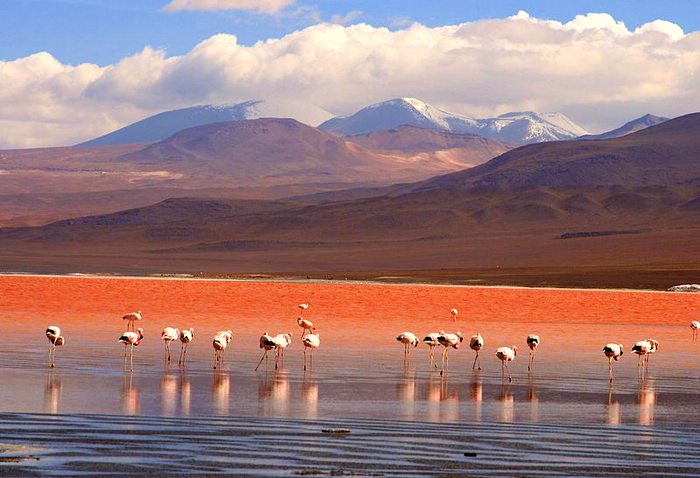 A total of 3 species of flamingos have found a home in the area: the James flamingo, Chilean flamingo and Andean flamingo
A total of 3 species of flamingos have found a home in the area: the James flamingo, Chilean flamingo and Andean flamingo
Photo by Carlos Adampol Galindo/Wikimedia Commons
The fun does not stop there! After taking in the beauty of the Red Lake, continue on to explore Dali’s Valley, a dry desert landscape, and make a stop at the Chalviri hot springs and Sol de Mañana geysers. Your day comes to an end with a stunning highlight and crowd favorite: the Laguna Verde (Green Lake), located at the base of the Llicancahur Volcano. The beautiful green color of the lake results from sediments that contain copper minerals.
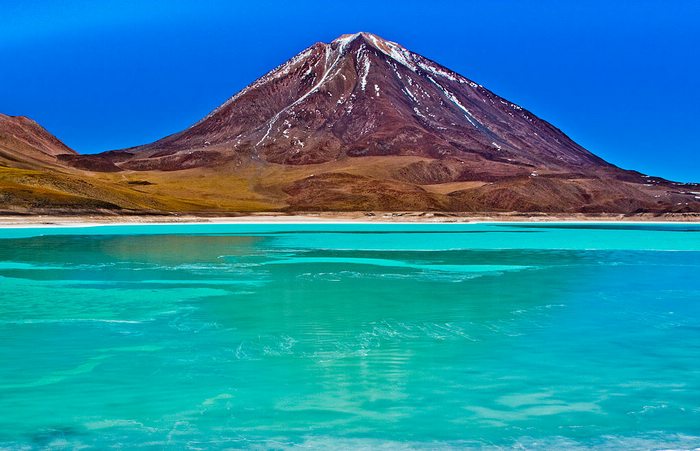 The Laguna Verde in all its green glory
The Laguna Verde in all its green glory
Photo by Pedro Szekely/Wikimedia commons
The colors and formations in the Uyuni Salt Flats are unprecedented and a true wonder of nature.
Day 3 – Saying goodbye to salt
Your Uyuni Salt Flats tour is approaching its end on day 3, but there are still some sights to go see! After breakfast at your hotel you will head to Incahuasi Island. This island is known for housing a unique species of giant cactus. Incahuasi Island is a very unique place: a rocky, cacti-covered island that stands in the center of a huge white salt plane.
 Incahuasi island stands in strict contrast to the white salt flats
Incahuasi island stands in strict contrast to the white salt flats
Photo by Boris G/Flickr
Finally you will go back to Uyuni to go and see traditional salt-mining techniques, and explore a splendid landscape feature: Ojos de Agua, round holes on the crust that allow you to see bubbling water under the thick layers of salt. You will work up quite the appetite from all this! Enjoy lunch on the salt flats before your transfer to the airport for your flight back to La Paz… and journey on to your next adventure!
Alternatively, you can always customize your travel package for an even deeper exploration of Uyuni or discover our full range of travel destinations to extend your vacation!
Plan your next adventure to Bolivia. Contact us today to speak with an experienced travel advisor to plan your dream trip!

Hendrika is Belgian but she considers herself a citizen of the world as she has lived in many different countries before moving to Peru. She fell in love with South America after her first visit to the continent in Bolivia, and has since then spent a lot of time traveling in the area. She especially enjoys Peru for its diversity, delicious food, and rich history.


